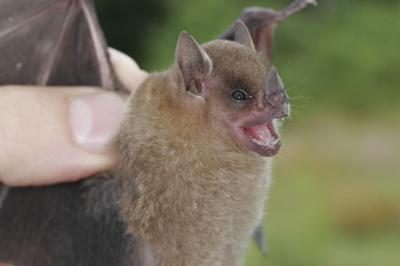Two new species of yellow-shouldered bats endemic to the Neotropics

This is Sturnira new species No. 3 (not yet described) from eastern Peru, photographed by B. D. Patterson, Field Museum of Natural History. Credit: B. D. Patterson, Field Museum of Natural History
These two new additions to the genus Sturnira are part of a recent discovery of three bats hidden away in collections around the world, the third one still waiting to be officially announced.
Up until recently the genus Sturnira was believed to contain only 14 species. In the last years closer morphological and molecular analysis have revealed an unexpected species richness in the genus. Sturnira now includes 22 described species, making it the most speciose genus in the Neotropical bat family Phyllostomidae.
Phyllostomidae, or the New World leaf-nosed bats are exclusively found in the biodiversity rich tropical areas of Central and South America. Both the scientific and common names of these bats refer to their often large, lance-shaped noseleaves. Because these bats use echolocation to orientate in the darkness the “nose-leaf” is thought to serve some role in fine-tuning their call.
All species in the yellow-shouldered genus Sturnira are frugivorous which means they feed largely on fruit. They are endemic to the Neotropics where they inhabit tropical lowland and montane forests. In fact the greatest diversity in the genus occurs on the elevated forested slopes of the Andes where at least 11 species occur.
The two newly described species, Sturnira bakeri and Sturnira burtonlimi occur in western Ecuador and in Costa Rica and Panama. The reason why they went unrecognized in collections is a superficial resemblance with other species in the genus, most of which were described without adequate illustrations to communicate identifying characteristics. Only after an in-depth molecular analysis that included over 100 samples from most of the species of the genus could the new species be identified. “Modern electronic publications like ZooKeys permit extensive and detailed color photography to accompany taxonomic descriptions. Any reader can easily and clearly appreciate the character states we use to distinguish these new taxa” said co-author Bruce Patterson.
Original Source:
Velazco PM, Patterson BD (2014) Two new species of yellow-shouldered bats, genus Sturnira Gray, 1842 (Chiroptera, Phyllostomidae) from Costa Rica, Panama and western Ecuador. ZooKeys 402: 43-66. doi: 10.3897/zookeys.402.7228
Media Contact
More Information:
http://www.amnh.orgAll latest news from the category: Life Sciences and Chemistry
Articles and reports from the Life Sciences and chemistry area deal with applied and basic research into modern biology, chemistry and human medicine.
Valuable information can be found on a range of life sciences fields including bacteriology, biochemistry, bionics, bioinformatics, biophysics, biotechnology, genetics, geobotany, human biology, marine biology, microbiology, molecular biology, cellular biology, zoology, bioinorganic chemistry, microchemistry and environmental chemistry.
Newest articles

Properties of new materials for microchips
… can now be measured well. Reseachers of Delft University of Technology demonstrated measuring performance properties of ultrathin silicon membranes. Making ever smaller and more powerful chips requires new ultrathin…

Floating solar’s potential
… to support sustainable development by addressing climate, water, and energy goals holistically. A new study published this week in Nature Energy raises the potential for floating solar photovoltaics (FPV)…

Skyrmions move at record speeds
… a step towards the computing of the future. An international research team led by scientists from the CNRS1 has discovered that the magnetic nanobubbles2 known as skyrmions can be…





















